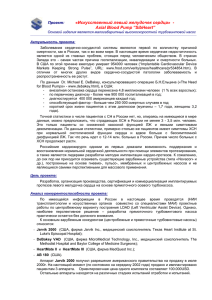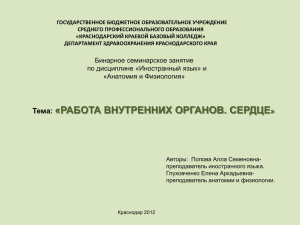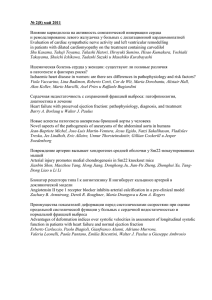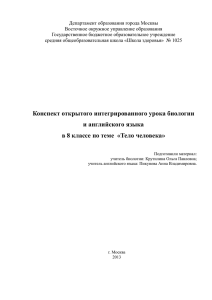Ebenezer Hernia
реклама
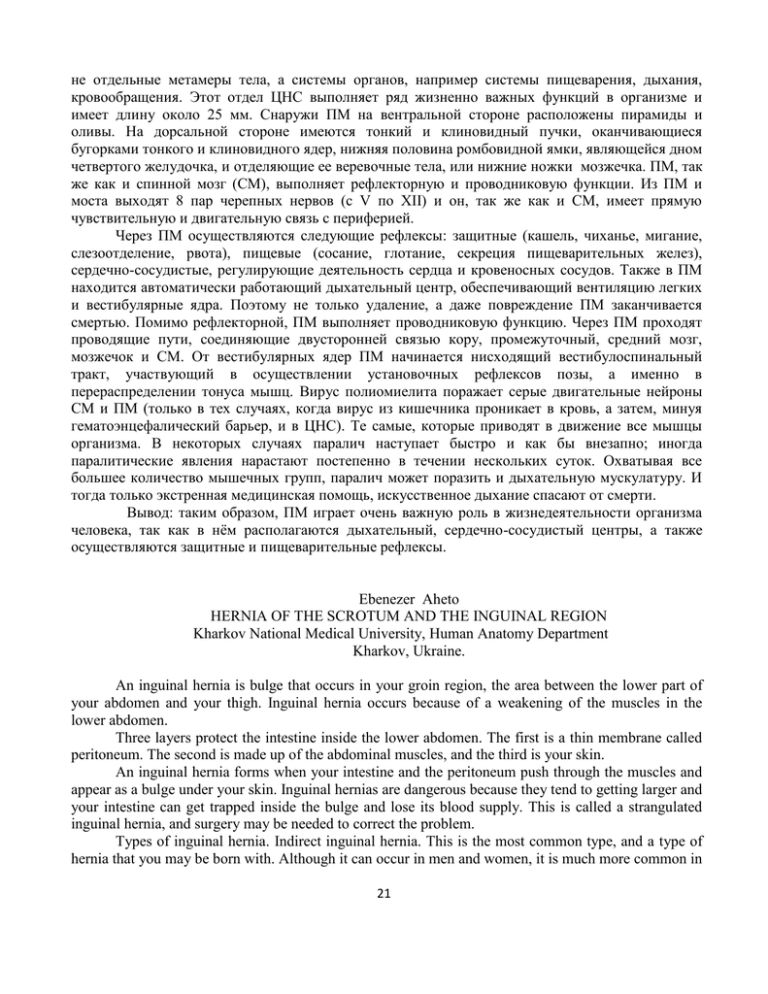
не отдельные метамеры тела, а системы органов, например системы пищеварения, дыхания, кровообращения. Этот отдел ЦНС выполняет ряд жизненно важных функций в организме и имеет длину около 25 мм. Снаружи ПМ на вентральной стороне расположены пирамиды и оливы. На дорсальной стороне имеются тонкий и клиновидный пучки, оканчивающиеся бугорками тонкого и клиновидного ядер, нижняя половина ромбовидной ямки, являющейся дном четвертого желудочка, и отделяющие ее веревочные тела, или нижние ножки мозжечка. ПМ, так же как и спинной мозг (СМ), выполняет рефлекторную и проводниковую функции. Из ПМ и моста выходят 8 пар черепных нервов (с V по XII) и он, так же как и СМ, имеет прямую чувствительную и двигательную связь с периферией. Через ПМ осуществляются следующие рефлексы: защитные (кашель, чиханье, мигание, слезоотделение, рвота), пищевые (сосание, глотание, секреция пищеварительных желез), сердечно-сосудистые, регулирующие деятельность сердца и кровеносных сосудов. Также в ПМ находится автоматически работающий дыхательный центр, обеспечивающий вентиляцию легких и вестибулярные ядра. Поэтому не только удаление, а даже повреждение ПМ заканчивается смертью. Помимо рефлекторной, ПМ выполняет проводниковую функцию. Через ПМ проходят проводящие пути, соединяющие двусторонней связью кору, промежуточный, средний мозг, мозжечок и СМ. От вестибулярных ядер ПМ начинается нисходящий вестибулоспинальный тракт, участвующий в осуществлении установочных рефлексов позы, а именно в перераспределении тонуса мышц. Вирус полиомиелита поражает серые двигательные нейроны СМ и ПМ (только в тех случаях, когда вирус из кишечника проникает в кровь, а затем, минуя гематоэнцефалический барьер, и в ЦНС). Те самые, которые приводят в движение все мышцы организма. В некоторых случаях паралич наступает быстро и как бы внезапно; иногда паралитические явления нарастают постепенно в течении нескольких суток. Охватывая все большее количество мышечных групп, паралич может поразить и дыхательную мускулатуру. И тогда только экстренная медицинская помощь, искусственное дыхание спасают от смерти. Вывод: таким образом, ПМ играет очень важную роль в жизнедеятельности организма человека, так как в нём располагаются дыхательный, сердечно-сосудистый центры, а также осуществляются защитные и пищеварительные рефлексы. Ebenezer Aheto HERNIA OF THE SCROTUM AND THE INGUINAL REGION Kharkov National Medical University, Human Anatomy Department Kharkov, Ukraine. An inguinal hernia is bulge that occurs in your groin region, the area between the lower part of your abdomen and your thigh. Inguinal hernia occurs because of a weakening of the muscles in the lower abdomen. Three layers protect the intestine inside the lower abdomen. The first is a thin membrane called peritoneum. The second is made up of the abdominal muscles, and the third is your skin. An inguinal hernia forms when your intestine and the peritoneum push through the muscles and appear as a bulge under your skin. Inguinal hernias are dangerous because they tend to getting larger and your intestine can get trapped inside the bulge and lose its blood supply. This is called a strangulated inguinal hernia, and surgery may be needed to correct the problem. Types of inguinal hernia. Indirect inguinal hernia. This is the most common type, and a type of hernia that you may be born with. Although it can occur in men and women, it is much more common in 21 men. This is because the male testicles starts inside the abdomen and has to go down through an opening in the groin area to reach the scrotum (the sac that holds the testicles). If this opening does not close at birth, a hernia develops. In women, this type of hernia can occur if reproductive organs or the small intestine slides into the groin area because of a weakness in the abdominal muscles. Direct inguinal hernia. This type hernia is caused by weakening of your abdominal muscles over time and is more likely to be seen in adults. It occurs only in men. Symptoms: 1. A bulge that increases in size when you strain and disappear when you lied down 2. Sudden pain in your groin or scrotum when exercising or straining 3. A feeling of weakness, pressure, burning, or aching in your groin or scrotum Diagnosisand treatment:Inguinal hernia is most often diagnosed through a medical history and physical examination. Your doctor asks you questions about hernia symptoms he then look for and feel for a bulge in your groin or scrotal area. 1. Opening repair 2. Laparoscopy Asoh Smith Ekanya THE ANATOMY AND PATHOLOGY OF THE HUMAN HEART Kharkov National Medical University, Human Anatomy Department Kharkov, Ukraine. The heart is a hollow muscular organ which receives blood from the venous trunks draining into it and pumps the blood into the arterial system. The heart is cone-shaped and has a rounded apex that faces downward and a base directed upward. Topography of the heart. The heart is located asymmetrically in the anterior mediastinum. Its greater parties to the left of the midline and only the right atrium and both venacavae creates the right. The greater part of the anterior surface of the heart is covered by the lungs, except for one area which by the pericardium attaches to the sternum and cartilage of the fifth and sixth left ribs. Structure of the heart walls. The walls of the heart is made of three layers: 1. An inner layer lining the inner surface of the heart cavities called endocardium. 2. A middle muscular layer called myocardium consists of fibres of the atriums, ventricles and atrioventricular bundle of His. 3. An outer layer, theepicardium, is the visceral layer of the serous pericardium. Chambers of the heart. The heart has four chambers; two atria and two ventricles. The atria are the blood –receiving chambers. The ventricles pump blood from the heart into the arteries. The atria are separated by the inter-atria septum and the ventricles are separated by the inter-ventricular septum. Contraction of the walls of the heart chambers is called systole and their relaxation is called diastole. Muscles and valves lining the inner heart: 1. The anterior and posterior papillary muscles: are two in number ,one being connected to the anterior, the other to the posterior wall.They are of large size and end in rounded extremities from which the chordae tendinae arise. 2. Chordae Tendineae: pull on the atrioventricular valves and prevents it from folding backward and allowing blood to regurgitate pass them. 22
